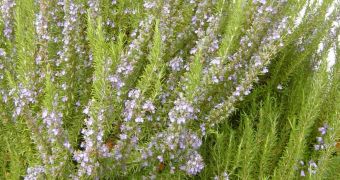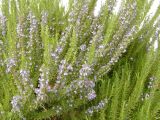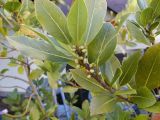The rosemary (Rosmarinus officinalis) is a Mediterranean evergreen bush which thrives in shadowed places, being inhibited by cold and wet winters. It prefers dry, sunny areas, with well drained soil which is protected against cold winds (that's' why it must be relocated to a room inside the house if there the weather outside is freezing).
It grows up to 2 m (6 ft) tall, especially if cut well after blooming to stimulate the growth of its branches. On limy soils, the scent spread by the rosemary bush is stronger. Add garden lime or ground egg shell on its soil to achieve this. The plant can be propagated through cuts, after having developed roots.
There are many varieties if rosemary, and the flowers vary in color from white and blue to pinkish hues. It is of rapid growth, and because of its density and height, it is ideal for hedges. 400 years ago, the rosemary was used just for ornamental purposes and it was often cut to achieve complex shapes.
It was also commonly used in the weddings, both for adorning the church and the heads of the new spouses.
Rosemary, from the peppermint family, is a common presence in the Mediterranean culture, and it is mentioned even in the Bible. In Antiquity, it was attributed medicinal properties and it was often used for disinfecting the rooms of the diseased. During the pest time, it was worn above, and smelt while passing through an affected area.
The University people worn rosemary garlands on the head for fortifying their memory, and that's why the plant is linked to fidelity.
Rosemary seeds, minute and oily, have no function other than to reproduce the plant. The leaves, full of aromatic volatile oils, are harvested throughout the year in small amounts, but the best moment is before blooming. The leaves are separated from the branch before being bottled (when well tapped, they preserve the aroma better), and must not be ground (when they spread the aromatic scent) before using them, with the aim of preserving their whole flavor.
The rosemary scent is typical for the plant, and is popular in medicine and cuisine. The fresh or dry leaves are employed for seasoning meat dishes, lamb meat and pork, and also for increasing the flavor of vinegars and oils (by adding some rosemary branches or leaves). Fresh rosemary is also added to salads, and burned branches give flavor to meat. Rosemary is the main ingredient in the classic mix of dry herbs of the Provencal cuisine from southern France.
Medically, the rosemary has interesting tonic properties, improving blood circulation and fighting arterial stiffness. Infusions, three times a day, are good for fighting light depressions, hangovers and headaches.
In cosmetics, its oils are used for making cologne water and the fresh or dry leaves are used for inhalations which stimulate facial blood circulation. The infusion gives a lighter hair color.
In the house, fresh branches perfume the environment and chase away the insects. It is also effective against moths. Burned branches spread an aromatic smoke.
Still, its use is not recommended for epileptics, and should be avoided during pregnancy and breastfeeding. The plant must not be used for a very long time, either.
Bay laurel (Laurus nobilis) is also a common ingredient in the Mediterranean cuisine. As a spice, it eases the digestion of heavy dishes. Added in the bathing water, it alleviates the limb pains, and burning its leaves disinfects the environment. But the plant can produce skin allergies when in contact with the skin and as an ingredient in food or drinks during pregnancy can trigger contractions.

 14 DAY TRIAL //
14 DAY TRIAL // 

